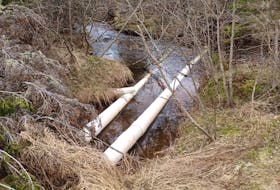A team of researchers, including a scientist from Prince Edward Island, is working to ensure that lobsters continue to thrive, in spite of climate change.
New research by the University of Maine, Dalhousie University and the University of Prince Edward Island has found ocean acidification and rising temperature have caused changes to lobsters’ immune system and shell production.
Researchers worked together across borders to look ahead to ocean conditions in the year 2100 to see the impacts of climate change on a molecular level.
“Ocean acidification is really happening now, whereas, temperature is happening now but is going to get worse. In the Gulf of Maine, it is warming faster than 99 per cent of the water on earth, so it’s really a hotbed for changing temperatures,” said Fraser Clark, a former Kensington, P.E.I., resident and currently a researcher with Dalhousie University, who is one of the authors of the study.
Clark was at the Atlantic Veterinary College at UPEI when he first teamed up with researchers from the University of Maine to study the lobster larvae.
“They really wanted to dig into the molecular, sub-cellular processes to see if they could see small changes,” said Clark.
All about lobster larvae
- Lobster hatch from eggs that are kept on the mother’s tail. Once they hatch, she flicks the larvae off into the water where they begin to eat right away.
- Larvae are usually released between June and September and stay larvae for between three to 12 weeks.
- Larvae are transparent and about the size of a pea when they are released.
- Larvae molt several times before they become juveniles.
The now-published study was part of Maura Niemisto’s master’s thesis at the University of Maine.
She started with freshly hatched lobster larvae from waters off Rhode Island and reared them in various tanks – some with normal conditions, some with increased temperatures, some with increased dissolved carbon dioxide (pCO2) and some with both increased temperature and increased pCO2.
When carbon dioxide is absorbed into the ocean it causes a change in the pH and the water becomes more acidic; it is measured as pCO2.
Once the lobsters were the right age and had been living in the conditions for a month, she sent frozen samples to Clark so he could extract the lobster RNA. Then she travelled to Canada herself to work with Clark on the analysis.

The RNA transcripts they extracted make the building blocks for everything from lobster shells to lobster immune systems.
“When we’re looking at these RNA responses, what we’re looking for is like, ‘Something’s going on. What are your cells doing to make sure everything continues to function as normal as possible?’ and that (reaction) can be indications of stress,” said Niemisto.
After extraction, the RNA was sent away for sequencing – a process that translates the RNA molecules into text.
“It’s hundreds of millions of sequences that come back, so to analyze that we used some big computing infrastructure,” said Clark.
“That was great, he gave me kind of a boot camp in bioinformatics,” said Niemisto, referring to the science of collecting and analyzing complex data such as genetic codes.
Analysis showed more than 1,100 RNA transcripts were impacted by her experiment. It may sound like a lot, but it was only 0.27 per cent of the transcripts they sequenced.
However, the results were significant – they showed lobster shell development, stress response and immune function were most impacted by the increase in temperature and acidity.

Niemisto is a zooplankton scientist, so lobster larvae were of particular interest to her – and not just because they’re tiny and live in the water column.
“Lobsters are a really important species both in Canada and in the United States,” said Niemisto. “(The study was) an effort to inform things like management and fishing regulations, and just our overall understanding of climate change – and not only our fisheries but our aquatic ecosystems. So important culturally and biologically.”
Clark agrees, saying the work is important to illustrate what could happen.
“It’s really important to collaborate with what the fishers and what the government regulators are seeing. We need these sorts of studies to help predict how we can implement measures to make sure that we have lots of lobsters that are healthy and delicious and keep a lot of people employed,” said Clark.
There’s lots more work to be done to understand how the lobsters will be impacted, but ocean acidification and rising temperature are already having serious consequences for other shellfish. Clark said that on the West Coast, the water is too acidic for baby mussels and oysters and the shells dissolve.
“The oceans have acidified much faster than the air has warmed,” said Clark. “Everybody talks about, when they talk about global warming, is climate change, but the changes have already happened in the oceans.”
Alison Jenkins is a local journalism initiative reporter, a position funded by the federal government.









